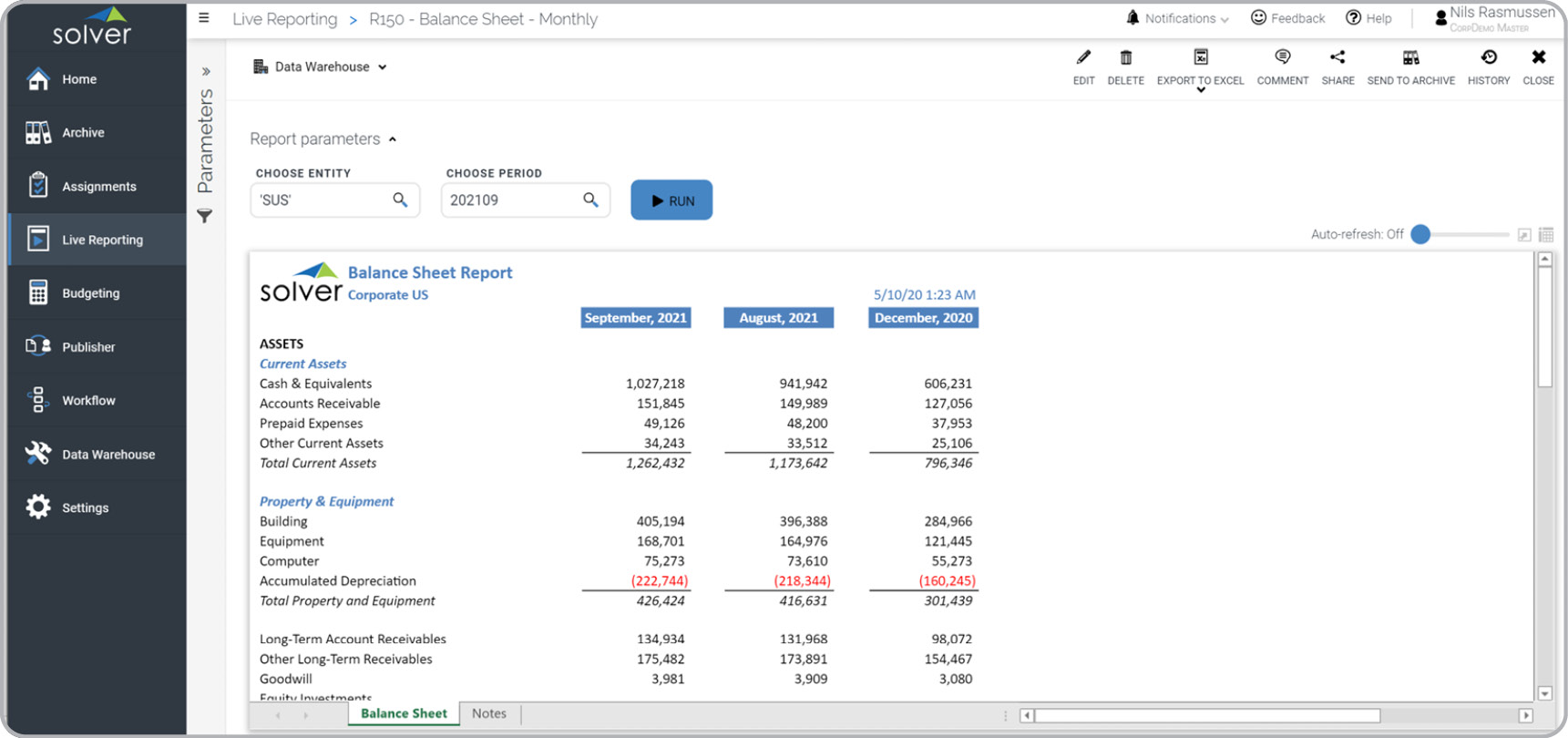Monthly Balance Sheet with Prior Month and Last Year Comparisons
What is
a
Monthly Balance Sheet with Prior Month and Last Year Comparisons
? Monthly Balance Sheet reports are considered essential month-end financial statements and are used by CFOs and accountants to review key elements of the company's assets and liabilities. Some functionality in this type of report is parameter driven and will populate the data and headers in three columns. You will find an example of this type of report below.
Purpose of
Monthly Balance Sheets Companies and organizations use Monthly Balance Sheets to easily track month-over-month performance of assets and liabilities. When used as part of good business practices in a Finance and Accounting Department, a company can improve its monthly reporting automation and fiscal control as well as reduce the chances that important changes goes undetected.
Monthly Balance Sheet
Example Here is an example of a Balance Sheet with current month, prior month and last year balances. [caption id="" align="alignnone" width="1721"]
 Monthly Balance Sheet with Prior Month and Last Year Comparisons Example[/caption] You can find hundreds of additional examples
here.
Who Uses This Type of
Report
? The typical users of this type of report are: CFOs, Controllers and Accountants.
Other
Report
s Often Used in Conjunction with
Monthly Balance Sheets Progressive Finance and Accounting Departments sometimes use several different Monthly Balance Sheets, along with monthly profit & loss, cash flow statements and other management and control tools.
Where Does the Data for Analysis Originate From? The Actual (historical transactions) data typically comes from enterprise resource planning (ERP) systems like: Microsoft Dynamics 365 (D365) Finance, Microsoft Dynamics 365 Business Central (D365 BC), Microsoft Dynamics AX, Microsoft Dynamics NAV, Microsoft Dynamics GP, Microsoft Dynamics SL, Sage Intacct, Sage 100, Sage 300, Sage 500, Sage X3, SAP Business One, SAP ByDesign, Acumatica, Netsuite and others. In analyses where budgets or forecasts are used, the planning data most often originates from in-house Excel spreadsheet models or from professional corporate performance management (CPM/EPM) solutions.
What Tools are Typically used for Reporting, Planning and Dashboards? Examples of business software used with the data and ERPs mentioned above are:
Monthly Balance Sheet with Prior Month and Last Year Comparisons Example[/caption] You can find hundreds of additional examples
here.
Who Uses This Type of
Report
? The typical users of this type of report are: CFOs, Controllers and Accountants.
Other
Report
s Often Used in Conjunction with
Monthly Balance Sheets Progressive Finance and Accounting Departments sometimes use several different Monthly Balance Sheets, along with monthly profit & loss, cash flow statements and other management and control tools.
Where Does the Data for Analysis Originate From? The Actual (historical transactions) data typically comes from enterprise resource planning (ERP) systems like: Microsoft Dynamics 365 (D365) Finance, Microsoft Dynamics 365 Business Central (D365 BC), Microsoft Dynamics AX, Microsoft Dynamics NAV, Microsoft Dynamics GP, Microsoft Dynamics SL, Sage Intacct, Sage 100, Sage 300, Sage 500, Sage X3, SAP Business One, SAP ByDesign, Acumatica, Netsuite and others. In analyses where budgets or forecasts are used, the planning data most often originates from in-house Excel spreadsheet models or from professional corporate performance management (CPM/EPM) solutions.
What Tools are Typically used for Reporting, Planning and Dashboards? Examples of business software used with the data and ERPs mentioned above are:
- Native ERP report writers and query tools
- Spreadsheets (for example Microsoft Excel)
- Corporate Performance Management (CPM) tools (for example Solver)
- Dashboards (for example Microsoft Power BI and Tableau)
Corporate Performance Management (CPM) Cloud Solutions and More Examples
August 20, 2020
TAGS:
Reporting,
Solver,
report writer,
Microsoft,
consolidation,
template,
practice,
Acumatica,
Netsuite,
Finance,
GP,
Business Central,
excel,
last year,
ax,
prior month,
forecast,
Budget,
forecasting,
budgeting,
end,
Cloud,
Software,
Tableau,
SAP,
example,
best,
Sage,
BC,
D365,
NAV,
Intacct,
Balance Sheet,
CPM,
report,
SL,
Management,
dynamics,
Power BI

